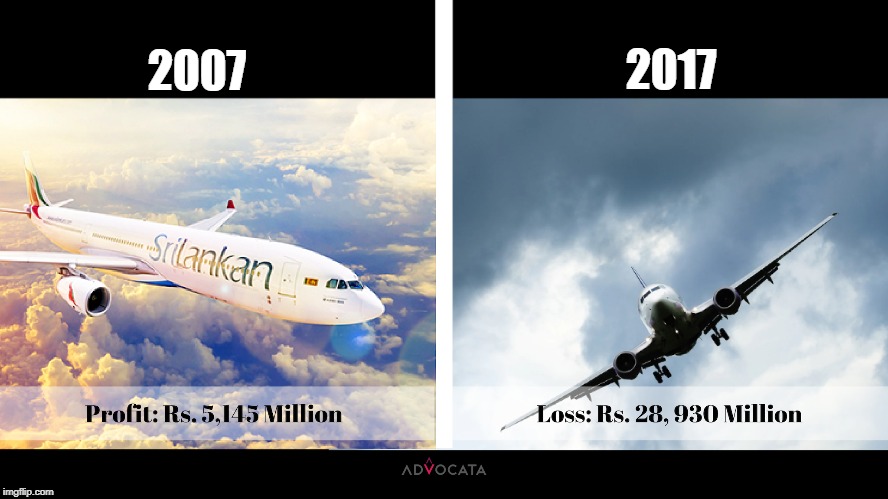Originally appeared on Sunday Times
By Aneetha Warusavitarana
The government’s policy document ‘Vision 2025: A Country Enriched’ positions Sri Lanka as a knowledge based, highly competitive, social market economy; and much of the content of the document is in line with increasing competition, productivity and efficiency.
The state of SriLankan Airlines, however, is in the antithesis of efficiency and productivity. The airline has been raking in losses for years now, and on Monday the 7th of January, the president appointed a committee to once again work on its restructuring. The new committee will assess the previous reports and restructuring plans and have now completed their recommendations.
It is evident that state ownership of this airline is not working, so what are the solutions?
Back when SriLankan Airlines was still Air Lanka, it was privatised. The government sold a 40% shareholding to Emirates Airlines in 1998, and contracted Emirates to manage the company for ten years with the government of Sri Lanka retaining majority shareholding. In 2008, the government took back complete ownership of the airline, and from then on, the losses began [1].
Source: Sri Lankan Treasury Annual Report (2008, 2018)
Privatisation has worked in the past, and the argument for privatisation of a state-owned airline is strong. To begin with, the aviation industry is an investment heavy industry, which requires expertise and foresight. Beyond procuring airplanes and terminal space, there is a web of domestic and international regulations to navigate, not to mention standards to adhere to. From then on, once you have the planes and are ready to start, the airline needs to be competitive in order to survive. It requires strong management and effective marketing, with a team that can adapt to external shocks in fuel prices, domestic and international politics, and changes in foreign exchange rates. Even if it has the money, a government is ill-equipped for this task, evidenced by the track record of the airline in state hands. During the period of 2009-2017, when the airline was under state management, it has accumulated losses of Rs. 148,707 Mn [2]. Repeated promises of restructuring or turnaround have remained unfulfilled.
While privatisation of SOEs, and specifically the privatisation of state-owned airlines is theoretically sound, appropriate implementation is necessary. The Organization for Economic Co-operation and Development (OECD) has done extensive research on privatisation of state-owned enterprises and has identified some key features that successful privatisations have had in common. Detailed below are some features that are relevant to Sri Lanka [3].
Strong political commitment to privatisation at the highest level in order to overcome bureaucratic inertia and to resolve inter-institution rivalries in order to move the process forward.
Clearly identified and prioritised objectives in order to provide the policy with focus and a sense of trade-offs that may be required.
A transparent process to enhance the integrity of the privatisation process, gain credibility with potential investors and political support from the public.
An effective communication campaign to explain the policy objectives of privatisation and the means by which they are to be achieved in order to respond to public concerns and to gain support for the policy.
Allocation of adequate resources in order to meet the demands of the shift to privatization.
Partial privatisation of SriLankan as a more viable solution?
Privatisation does not always have to be full divestiture of the asset; the option of partial privatisation is open. In this scenario, governments sell a minority stake and retain a degree of control, while the enterprise reaps the benefits that accompany privatisation. The process of privatisation will bring with it a much needed infusion of private equity, new management, clearly defined guidelines and a more flexible financial structure. The focus of the airline will shift towards increasing profitability and efficiency, with the aim of increasing shareholder value. Given Sri Lanka’s past success story with the partial privatisation of Air Lanka, it is possible that this solution will be pursued or at least considered.
The pitfall of partial privatisation
Drawing from the experience of privatisation in other countries when governments remain the majority shareholder, the space for political interference continues to exist [4]. This is the biggest potential pitfall, and the SriLankan experience can attest to the damage this can cause. As of now the government is struggling to create interest in the purchase of the airlines, and the fear that the government will once again step in and interfere with the management is the most probable reason behind this.
If the government is considering partial privatisation, steps should be taken to ensure that the government’s interests remain those of a shareholder and not those of a political entity. Given past track records, assurances of non-interference are unlikely to inspire confidence.
In 2015 the Hon. Prime Minister, Ranil Wickremesinghe mentioned that the government was considering the Singaporean Temasek model of a holding company as a solution to the problems of SOEs in Sri Lanka [5]. Establishing a holding company for SOEs would help bolster investor confidence and improve the functioning of the airline. It would professionalize the management and create distance from local politics [6]. It is a shame that even though this idea was brought out in 2015, it was never implemented. The question that remains is whether the government will take this into consideration and take decisive action on this problem four years later.
[1] Ratnasabapathy, R. (2016). The renationalisation of SriLankan airlines and the follies of state enterprise. In: The State of State Enterprises in Sri Lanka. Colombo: The Advocata Institute.
[2] Ten Year Review: SriLankan Airlines Annual Report 2016/17. Colombo.
[3] Privatising State-Owned Enterprises: An Overview of Policies and Practices in OECD Countries. (2003). Paris: OECD Publishing.
[4] Ibid
[5] Wettasinghe, C. (2015). Temasek model to make public enterprises viable. Daily Mirror. (Online - Accessed 16 Jan. 2019)
[6] Kim, K. (2018). Matchmaking: Establishment of state-owned holding companies in Indonesia. Asia & the Pacific Policy Studies, 5(2), pp.313-330.



